Generally when we consider the many plants around us, we imagine them efficiently using the electromagnetic radiation from the Sun via photosynthesis in their leaves — pulling carbon-dioxide from the air, as well as water from the soil via their roots, and grow as quickly as they reasonably can. In reality, the efficiency of this process is less than 10% of the input energy, and the different types of plant metabolisms that have formed over the course of evolution aren’t all the same.
Among the plant metabolisms in use today, some use significantly more efficient carbon fixation pathways, while others end up wasting a lot of the energy they obtained from photosynthesis with unnecessarily complicated processes, especially to deal with waste. How fast plants can grow if they had all evolved the most efficient carbon fixation pathway has been the subject of a number of studies these past decades, involving everything from crop plants to trees.
As these studies are showing us, more than a scientific and evolutionary biological curiosity, these genetically engineered plants offer real opportunities in everything from food production to reforestation.
Reinventing With Evolution
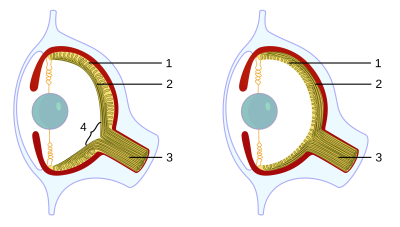
Over the course of billions of years on Earth, the process of evolution has led to the formation of fascinating biological structures, as well as many curious branching paths and incidences of reinventing the same structure differently. The vertebrate and cephalopod eyes for example, which appear to have formed independently, and are both very similar and wildly different. This process is called convergent evolution.
As striking as eyes and converging features such as wings among dinosaurs (birds), mammals and insects are, perhaps less obvious but no less important is the convergent evolution of photosynthesis. Over the course of millions of years, the rough versions of photosynthesis of early plants turned into a number of distinct photosynthesis pathways, all based around the RuBisCO (ribulose-1,5-bisphosphate carboxylase-oxygenase) enzyme and associated Calvin cycle.
Most plants use so-called C3 carbon fixation, which uses a fairly basic Calvin cycle. This has an overall efficiency of at most 3.5% (relative to Sun radiation energy input), whereas the less common C4 carbon fixation cycle peaks at over 4%. C4 and CAM (crassulacean acid metabolism) are a form of convergent evolution, where both use phosphoenolpyruvate (PEP) to capture CO2 and thus create an increased concentration of CO2 around the RuBiscCO enzymes to reduce photorespiration.
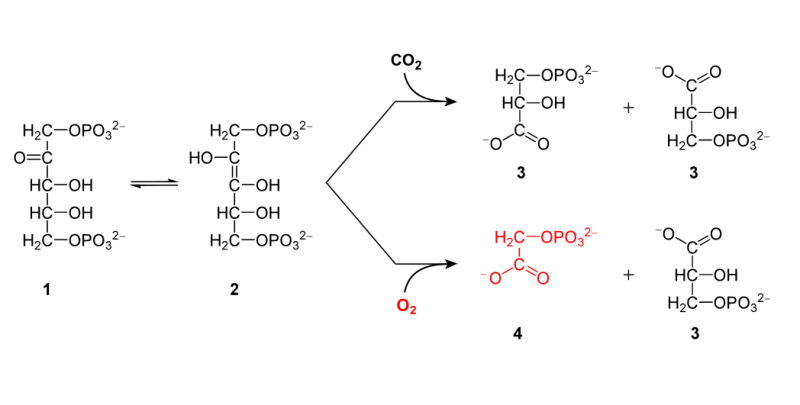
A core issue with RuBisCO as can be seen in its above listed reactions is that it reacts with both CO2 and O2, whereas the latter reaction is obviously undesirable due to the lack of carbon atoms involved. The 2-phosphoglycolate (2-PG, or C2H2O6P3-) metabolic product that results from the reaction with oxygen is toxic to the plant as it inhibits some metabolic pathways and thus has to be dealt with. This is where for C3 plants photorespiration is essential, as it allows for the 2-PG to be converted to the desired PGA (3-Phosphoglyceric acid) that is used for the formation of sugars the plant needs to thrive, as captured in this graphic by Williams et al. (2013) of the metabolic pathways for C3 and C4 plants:
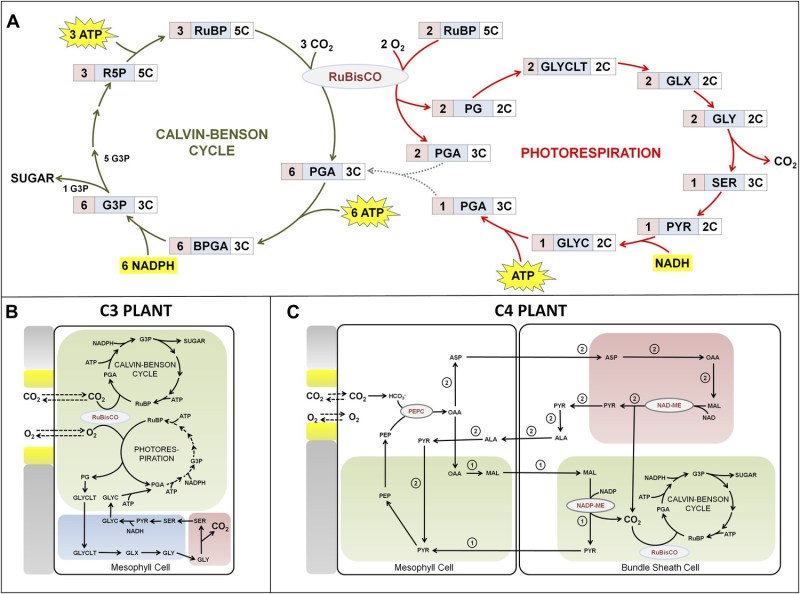
What this tells us is that many plants – including food crops and species of trees – which use the C3 carbon fixing cycle are spending a significant amount of the energy they gain from photosynthesis on breaking down this 2-PG that forms due to the interaction between RuBisCO and oxygen. Due to this photorespiration process, the loss of water via the stoma (pores) also increases.
Since RuBisCO binds more readily with oxygen rather than carbon-dioxide when temperatures increase, this puts natural limits on viable environmental conditions for C3 plants, and explains why C4 and especially CAM plants are found in warmer, more arid conditions. The logical conclusion thus is that if we were to transplant appropriate elements of the C4, CAM or other pathways as found in e.g. cyanobacteria into C3 plants, this could noticeably increase their growth rate by reducing the energy wasted on photorespiration.
Field Tests
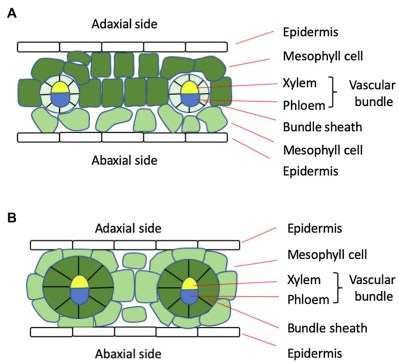
After initial attempts at tweaking the RuBisCo enzyme directly to increase its affinity for carbon-dioxide were less than successful, focus during the 1990s shifted to understanding and optimizing. At this point in time, it’s generally acknowledged that engineering C4-style carbon fixation in C3 plants is a viable path forward, by using existing C4 plants as template. Relevant here is whether a C3 species also has a related C4 species to make the genetic engineering more straight-forward. Another active point of discussion here is whether to pursue a one or two cell strategy, as noted by Cui (2021).
Other researchers have sought to find novel ways to enhance photosynthesis, such as Nölke et al. (2014), who added the expression of a polyprotein (DEFp) taken from Escherichia coli glycolate dehydrogenase (GlcDH) to potato plants (Solanum tuberosum), with a resulting 2.3x increase in tuber yield. This same approach can potentially be applied to other plants as well, with likely a similar yield increase.
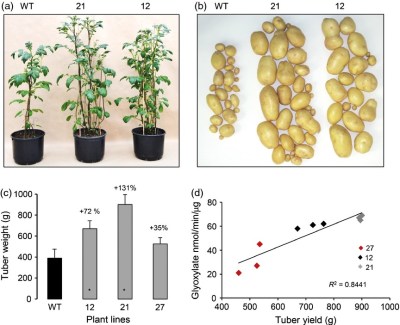
Wang et al. (2020) reported on a modified rice species using a similar approach as Nölke et al., albeit with mixed results. This study was followed by Nayak et al. (2022) who reported promising results that may lead to GE rice with these modifications being introduced in field trials. Related field trial data is available from South et al. (2019), who performed field trials using transgenic tobacco plants. These plants showed a roughly 40% boost in useful biomass production compared to the wild type.
Obviously, before any of these GE species would be distributed to farmers for next year’s crops a lot more experiments and field trials would have to be performed to ensure the effectiveness, long-term stability of these modifications and overall safety. Even so, these experiments provide a tempting glimpse at a future in which today’s agricultural output is increased by 150-200%, with zero need for additional nutrients, a decrease in water requirements and much better resistance to heatwaves, which are expected to occur much more regularly due to the ongoing climate change.
Which raises the question of whether a similar approach could be used to make regular trees much more efficient at fixing carbon from the atmosphere as well.
A Forest While You Wait
Conventional wisdom tells us that trees take a long time to grow. Perhaps unsurprisingly, most types of plants which are referred to as ‘trees’ (i.e. there is no biological definition of ‘tree’) use the C3 carbon fixation metabolism. In a recent preprint article by the Living Carbon Team et al. (2022), a modification akin to the previously discussed crop-based transgenic species is reported as having been applied to poplars. These hybrid poplars were subsequently planted in fields in Oregon, as detailed on the Living Carbon Team’s website. With the preprint article reporting a roughly 50% increase in biomass gain relative to standard poplars, this would lead credence to the lofty goals on the Living Carbon website
As explained on the FAQ page for the project, all the plants modified this way that are planted are female, ergo the genetic modifications will not spread to other, wild poplars via pollen, but will remain contained to just the planted trees. The project is done in partnership with Oregon State University (OSU), with over 600 of these hybrid poplars already planted. The goal is to get as many of them planted over the coming years as part of a carbon capture approach.
Together with the prospect of significantly boosting the output from crops, forests that grow 50% faster than conventional forests, this would seem to make for rather interesting future we can look forward to.
Genetic Engineering
One major elephant in the room when it comes to this topic is that of genetically modified organisms (GMOs), or “genetically engineered” (GE) as is the more correct term. Many countries have legislation that prohibits or severely limits the growing, import and sale of GE organisms, products, seeds, etc. Undoubtedly this will be the biggest hindrance in getting any of these photosynthesis-enhanced plants to be accepted.
Even though many arguments can be made for the inherent safety of these hybrid trees since neither humans nor cattle are likely to consume forests and trees in general, the divide between the logical world of science and the emotion-driven world of the average person and daily news cycle is stark indeed in this context.
Despite this, with the current course of the world towards one where droughts, famine and all other highly unpleasant symptoms of climate change will be felt by ever more people, it might be that the tools that science has provided us with will be our salvation here, allowing us to feed millions and make a sizable dent in the excess CO2 in the atmosphere, all by making plants better at hoarding carbon.

















Optimising pigments might be an approach for efficiency boost also…
http://hyperphysics.phy-astr.gsu.edu/hbase/Biology/pigpho.html#:~:text=They%20also%20have%20a%20red,that%20increases%20their%20photosynthetic%20efficiency.
Though we find currently known rapid growers like bamboo and kudzu to be a problem more than a benefit (Even though biofuel use would be beneficial to our situation)
Whether we wanna let Frankenstein crops loose on earth or not, they may be essential to support Mars colonists.
You might notice that basically nothing here mentioned chlorophyll or actual photosynthesis… because it doesn’t matter. Plants have plenty of energy: what they’re lacking is the ability to take in nutrients. Which is why you can’t just ramp up the light and get plants to grow faster.
Fundamentally this isn’t that surprising: light to energy is quick (electronic), sucking in atoms is slow.
I know for a fact that you can ramp up light and get pot to grow faster. If you don’t kill it with heat of course.
Especially if you supplement CO2…by brewing beer.
However, changes in laws make indoor pot growing increasingly unprofitable (in many states, coming to you soon). Wait till it’s federally legal and legal in Thailand. The old strains are hiding in some highland valley (we all hope).
Some asshole will make super Kudzu. Then we’re doomed.
I wonder if you could get a double whammy with aquaculture, run an oxygen concentrator bubbler to get your farmed salmon hyperventilating themselves huge, and dump the exhaust to your greenhouse.
People use fish tank bottom suckings as fertilizer. Mixed results.
Fish farm shit is a problem.
If you could find a way to economically collect it and sell to farmers you’d be rich and hippy chicks would throw their panties at you like Tom Jones. Fair warning, some will stick.
“run an oxygen concentrator bubbler to get your farmed salmon hyperventilating themselves huge,”
Plants need CO2, not oxygen. So you’re trying to use the salmon to convert O2 to CO2, right?
Where do you think the “C” would come from?
“I know for a fact that you can ramp up light”
Yes, of course if you start *from darkness* and ramp up light it’ll increase with light intensity. But once you reach the typical light levels that species of plant’s adapted to (and plants can adapt to *very* low light levels) the growth saturates. Doesn’t matter how much you protect the plant from the heat – if you dump more and more light, it saturates rather quickly.
If a plant’s outside in typical sunlight, it has far more energy than it can use. It does not, however, have far more CO2 than it can use – hence the reason why increasing CO2 levels above ambient still increases photosynthesis.
Light saturation point for basically all plants are within the typical range for sunlight – shining light on outdoor plants is pointless, so increasing the energy of light it takes in is also pointless. The CO2 saturation point for plants can be *huge* – like 3-4x outdoor levels – so increasing the efficiency of CO2 uptake is not pointless.
You’re defending a position you didn’t take.
Yes every plant has a maximum useable light level but most plants are living in places where more light will produce more growth. Even if it’s the same amount of light for more hours. Just change to brighter spots slowly so the sun doesn’t bleach them.
Why gardeners clear shade, but also why some plants are grown under cover.
Do we really want to further damage Earth’s biosphere and/or accelerate climate change when even proponents of colonization say it will be decades before radiation proof housing can be built (and much of that would likely have to be done underground), much less reducing radiation levels by inducing creation of a Martian ionosphere?
https://phys.org/news/2016-11-bad-mars.html
> Even though many arguments can be made for the inherent safety of these hybrid trees since neither humans nor cattle are likely to consume forests and trees in general, the divide between the logical world of science and the emotion-driven world of the average person and daily news cycle is stark indeed in this context.
Read: “Anyone who disagrees with me for any reason is below me and just being emotional”
In the future, know that there are more appropriate ways to establish that the topic of discussion is controversial, and also try to recognize that those with any amount of skepticism might not just be emotionally overreacting, but could have concerns you haven’t thought of.
“In the future, know that there are more appropriate ways to establish that the topic of discussion is controversial, and also try to recognize that those with any amount of skepticism might not just be emotionally overreacting, but could have concerns you haven’t thought of.”
How I long for a world that doesn’t vilify people of differing opinions (especially in politics).
Agree 100%. If the efficiency of the current plants is only 3.5%, while they had a million generation to enhance, there’s a reason. Simply injecting the C4 gene and observing *temporary* better result does NOT mean it’s better. It’s very likely such modified organisms, even if they breed wont support ecosystem changes as well as their natural cousin.
The main issue being that if the “new” optimal specie takes over, because, you know, Monsanto, and Marketing gods say so, when the next wave of whatever kill them all, you’re releasing all the (captured) CO2 at once in the atmosphere. And unfortunately, the original, genuine plant can’t be planted anymore to recover, since you don’t have that 50 years anymore to let them grow.
If some government had forbidden GE it’s not to piss Monsanto off, it’s because they are actual reasons why GE species in the long term aren’t that good. A good government doesn’t think for the next 5 years, but for the next 50 to 100 years.
> Agree 100%. If the efficiency of the current plants is only 3.5%, while they had a million generation to enhance, there’s a reason.
Evolution can easily get stuck in local maxima. C4 plants are quite recent, so they could plausibly just not have had time to spread into all relevent niches.
> If some government had forbidden GE it’s not to piss Monsanto off, it’s because they are actual reasons why GE species in the long term aren’t that good. A good government doesn’t think for the next 5 years, but for the next 50 to 100 years.
Governments aren’t actually “good” like that. Their reasoning is neither of those but just pandering to the wrong views of the public.
“all the plants modified this way that are planted are female, ”
Isn’t that the same plot as Jurassic Park: “All the Dinosaurs are female, so they can’t reproduce”. What could possibly go wrong?
B^)
That always drove me nuts. I mean, sterilization is easy, we’ve been doing it for generations. Hatch, knock em out, snip, you’re done.
Plus, y’know… don’t have carnivores.
I hate hermaphroditic plants! (Gives the girls the stink eye)
Am I cancelled?
So stop stressing them out! Subject yourself to 24 hours of continuous light day after day and see how well you fare. 👍
Happens much later in year, when they’re backed up and dripping in girl plant goo.
Absolutely fascinating subject; evolution, but lost me at Ribisco! Was lousy at school with biology/advanced a chemistry, but full kudos to those who get this. Totally in awe Maya.
Perhaps the separated at birth twin of Nabisco (nee National Biscuit Company)?
Mark Watney would certainly be a sucker for “double the calories per growth season”, but merely from looking at it, I’m being reminded of the ongoing question how much we are actually producing produce that is half the initial amount of other nutrients, but topped off with bare starch.
BBC has the story with lots of pretty pictures: https://www.bbc.com/future/bespoke/follow-the-food/why-modern-food-lost-its-nutrients/
Now with more energy available to GE plants, one could imagine they could also afford to produce more secondary metabolites and accumulate minerals. Let’s hope this time we’re optimizing plants with the bigger picture in mind, and don’t turn them in crops that are closer to highly processed foods than anything else.
Quit your bitchen. Humans have been starch eaters for most of history. Lucky to get meat, ever.
Eat your extruded, colored gruel. (Cheesy poofs!)
For decades people have complained about having GMO in their foods.
Then Covid hit and they lined up to have mRNA injected that makes them GMO.
A lot of people have refused the mRNA vaccine for exactly that reason, even though the mRNA does NOT modify your genome. It may not be the same group of people who were complaining about GMO in their food.
Personally I don’t think it is harmful for humans to eat GMO food, but that is a different question than wondering if it is wise to turn these modified organisms loose in nature. At one time, people had no qualms about turning rabbits loose in Australia, which they later came to regret.
If nature has not used evolution to optimize the efficiency of photosynthesis, it may be that the existing method is “good enough”. Evolution is a matter of random chance, unlike human engineering, evolution is not directed toward optimizing anything.
Evolution is absolutely about optimal solution, just not perhaps the ‘optimal’ route we humans desire…
I’d agree GMO food crops are very unlikely to be harmful, at least as part of a decent balanced diet, which is something most of us probably could do with working harder at.
Though I do agree as you point out Rabbits in Aus didn’t turn out so well, and its only one of many cases of much the same thing, now we are supposedly more knowledgeable as a species how about we learn from this mistake and take such tinkering with the local ecology as slow and controlled an experiment as we can, as long as you keep these modified plants safely contained or self destructing as they can’t reproduce and the modifications reasonably small it shouldn’t make a great deal of difference to the local ecology to have the plants around – Tiny changes to somethings genes to promote the specific x or y would make your engineered version less different from its brethren than all the many varieties of selective bred flower, horse, food animals in general – but its got to be responsible science, prove this plant can’t throw long shoots and clone itself or otherwise be entirely unmanageable before you really let them out of the controlled environment.
The variation in technique is key to the adaptability of life in general, disregarding species. Giant dragonflies, when the earth had the oxygen percentage to make their respiration system more viable and small dragonflies now. No doubt plants have had a similar fox and rabbit relationship with the climate. Considering how things have been changing over the last few centuries, who knows if pushing that multi-millennia old process will prove to be the correct course of action.
> Even though many arguments can be made for the inherent safety of these hybrid trees since neither humans nor cattle are likely to consume forests and trees in general…
Tell me you haven’t spent significant time around cattle without saying you haven’t spent significant time around cattle.
Yeah, right. And then, after academia has done all its research, Monsanto (now Bayer) steps in and inserts a Terminator gene, to “protect their intellectual poverty”.
Maya, this was a really interesting article indeed, which I enjoyed thoroughly. But mentioning legislation as a blocker to progress (which it sometimes is) without mentioning That Other Elephant in the Room which is corporate greed is just a cheap jab of the kind “state Bad — private Good”. That wasn’t necessary.
If I’m scared of GM organisms, then *just* because of corporate greed. The science part of it is fine, mind you.
+1 for intellectual poverty!
You don’t need a terminator gene to protect F1 hybrids. Learn some botany.